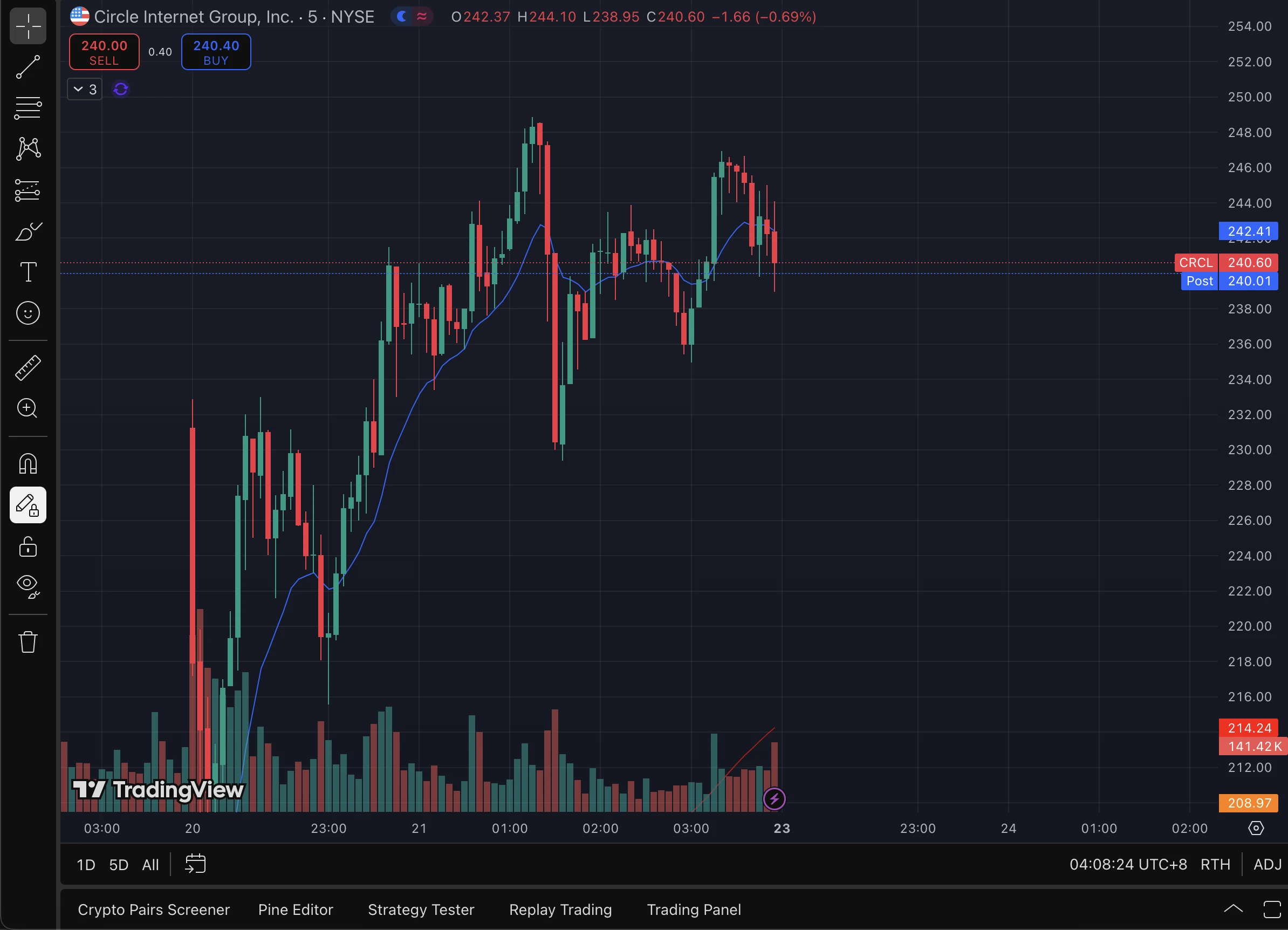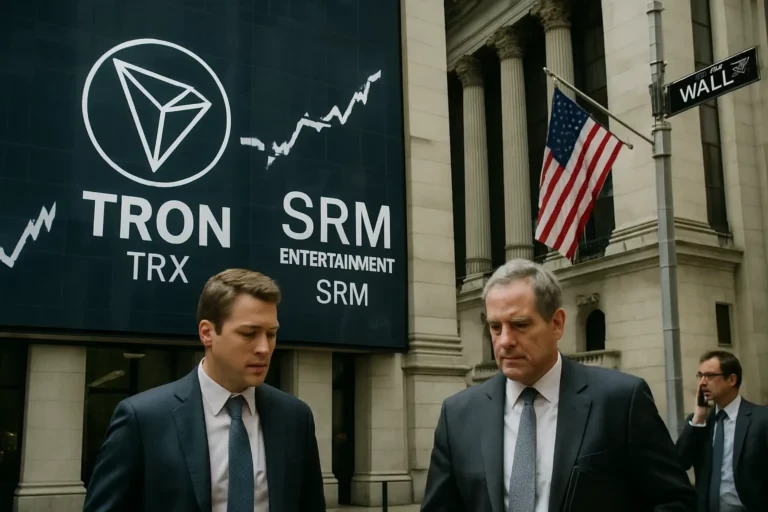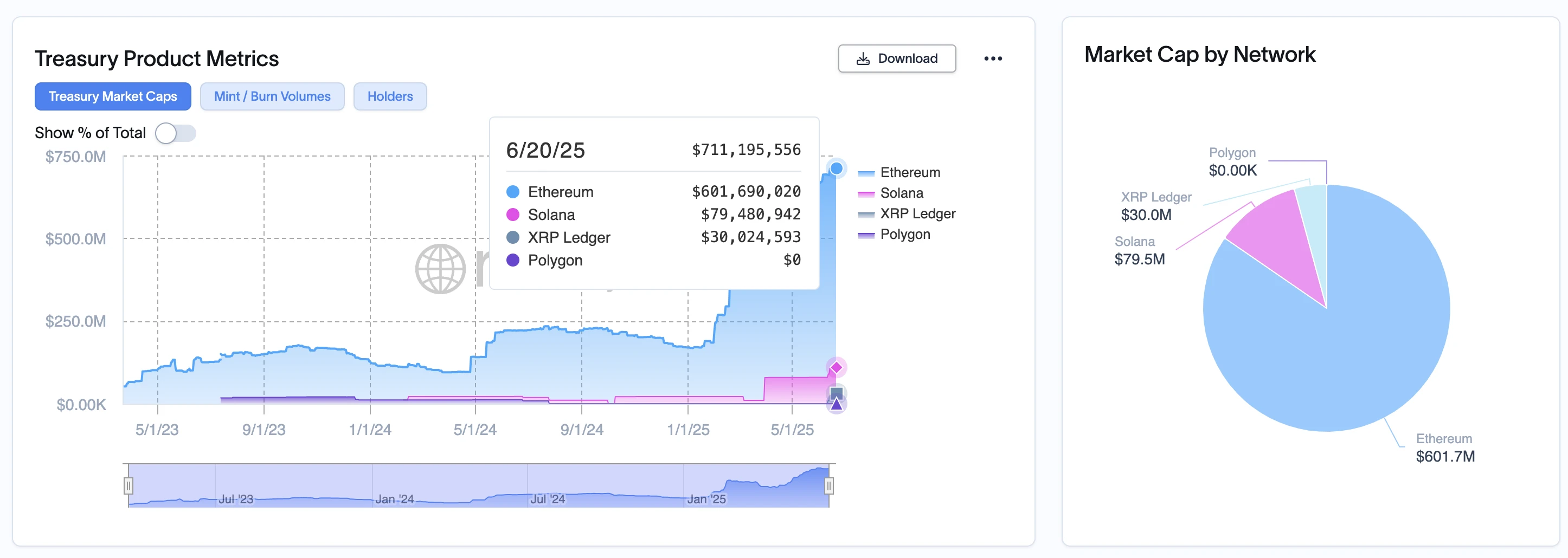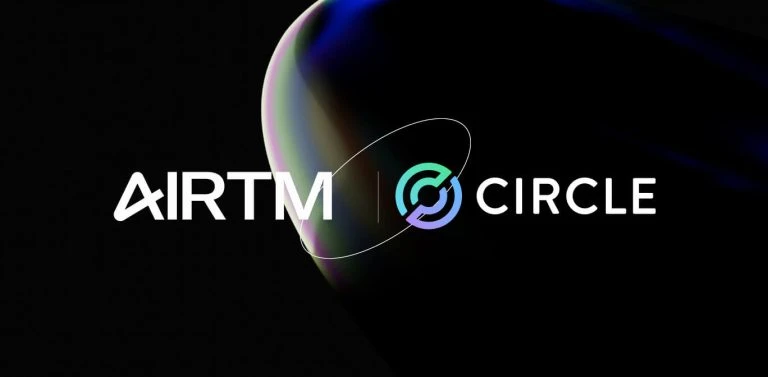Original | Odaily Planet Daily ( @OdailyChina )
Author | Ethan ( @ethanzhang_web3 )

On June 12, the U.S. Senate passed the Guidance and Establishment of a National Innovation for U.S. Stablecoins (GENIUS Act) with an overwhelming majority of 68 votes in favor and 30 votes against, establishing the first federal regulatory framework for stablecoins anchored to the U.S. dollar. This bill, known as the cornerstone of the digital infrastructure of the U.S. dollar, is now only a matter of passing the House of Representatives and being signed by President Trump to become law, and is expected to be officially implemented before the August recess of Congress.
The news of the bills passage quickly triggered a chain reaction in the market. Stablecoin issuer Circle was successfully listed on the New York Stock Exchange. On the first day of listing, its stock price soared by more than 200%. The current stock price is temporarily reported at US$240.6. Compared with its issue price of US$31, the increase has reached an astonishing 774%, becoming the first stablecoin stock (for details, please refer to Crypto Bull Market, All in US Stocks: Circles Ten Days from US$31 to US$165 ). At the same time, the total market value of stablecoins has exceeded US$250 billion, and the annual transaction volume has exceeded the total transaction volume of Visa and Mastercard. The number of active addresses worldwide has reached 261 million. Stablecoins have quietly become the water, electricity and coal of the global digital financial system.
This policy turning point is very similar to the moment of Internet legislation in the 1990s: those who set rules may not be innovators, but they are often the ones who accelerate maturity. When the policy wind blows, the market is destined to no longer be calm. So, in this stablecoin gold rush ignited by the GENIUS Act, who has already taken the lead? Who will rise? How can ordinary people get a share of the wave?

Market weathervane: Who will take the lead?
The passage of the GENIUS Act is triggering a structural reassessment of the entire capital market. Not only are stablecoin issuers enjoying “regulatory dividends”, but traditional financial institutions and technology giants are also betting on it, accelerating their entry into the compliant stablecoin ecosystem. A number of crypto concept stocks have even responded in advance, becoming a bellwether for the market to capture policy dividends.
Stablecoin issuers: Compliance giants welcome spring, while offshore players face challenges
Circle (CRCL): The issuer of the worlds second largest stablecoin USDC, is the first to benefit from the compliance dividends brought by the GENIUS Act. Circle was successfully listed on the New York Stock Exchange in June 2025, with an issue price of US$31. On the first day, the stock price soared to US$69, an increase of more than 200%, and the circuit breaker mechanism was triggered several times during the trading session. Circle has publicly stated that it will fully meet the GENIUS regulatory requirements, use US Treasury bonds and cash as core reserve assets, and become one of the representatives of US Dollar 2.0.
Licensed institutions such as Paxos and TrustToken (TUSD issuer) are also accelerating their transition to the GENIUS framework to obtain federal-level stablecoin issuance qualifications. In contrast, a number of offshore projects such as Tron USDD and Tether USDT (BVI registered) are facing pressure to disclose information and audit reserve structures. Once they encounter cross-chain liquidity restrictions or bank channel compression, they will gradually lose mainstream trading scenarios.
SBET (StableBet Technologies) : A new concept stock that has emerged in recent US stock trading, it is regarded as a dual-hot player in compliant stablecoin + on-chain gambling payment. The core of its product is to build a real-time clearing channel for USDC in a decentralized gambling platform, and it has been connected to the Base and Polygon on-chain ecosystems. After the GENIUS Act was announced, the stock rose by the daily limit for 3 consecutive days, triggering a rush for retail investors and institutions to buy.
Previously, Odaily Planet Daily had compiled and sorted out more details about U.S. crypto concept stocks, such as SRM Entertainment, SharpLink Gaming and Coinbase, in the article Crypto Bull Market, All in U.S. Stocks: Circles Ten Days from US$31 to US$165 .
Traditional financial institutions: actively embrace stablecoins and lay out a new digital landscape
JPMorgan: Its stablecoin project JPM Coin has been applied in internal settlements for a long time, and has now gradually expanded to connect to the USDC channel to provide on-chain clearing services for institutional clients. After the passage of the GENIUS Act, JPM announced that it was considering applying for a formal stablecoin license to expand its external client business.
Established banks such as Goldman Sachs, Citigroup, and Bank of America are accelerating their cooperation with compliant issuers such as Circle and Paxos to connect to stablecoin clearing pools through APIs to meet the surge in customer demand for real-time cross-border settlement and RWA tokenization.
SRM (Secure Reserve Management) : This is a company that is considered to be a pioneer in traditional asset management + stablecoin custody services. Its main service is the combined asset management based on government bonds + stablecoins. Its stock price has also been sought after after the passage of the GENIUS Act, and it is called the on-chain version of BlackRock. On June 16, the stock soared more than 5 times in a single day, and its market value soared from tens of millions to about 158 million US dollars. The surge stems from the companys announcement of a $100 million investment and the launch of the TRON token vault strategy, becoming the Tron version of MicroStrategy betting on crypto asset reserves. (Supplementary reading: Tron merges SRM with Nasdaq, Sun Yuchens wave is in the atmosphere )

Technology and Internet giants: Entering the payment and RWA tracks to expand the boundaries of application
Ant Group : In June 2025, it announced that it would simultaneously apply for compliance licenses related to stablecoin issuance in Hong Kong, Singapore, and Luxembourg, and has completed regulatory sandbox testing, becoming the first Asian Internet company to run a compliance path. Its Trusple on-chain payment + USDC settlement product has been piloted in Southeast Asia.
JD Technology : Quietly launched the On-chain Cross-border Procurement Settlement Platform, planning to connect to multiple stablecoin resources such as USDC and HKDC for supply chain settlement, especially for the One Belt One Road e-commerce scenario. In the future, it may open up the RWA custody function and embed blockchain invoices and asset rights confirmation. (Read more: After missing out on payment for ten years, Liu Qiangdong wants to use stablecoins to launch JDs second payment revolution? )
Amazon, Google, Apple, X and other American technology giants are also trying to integrate stablecoins into their payment systems through stablecoin wallets, NFT identity authentication, and cloud-hosted USDC accounts. For example, the Amazon Web3 team has reached a cooperation with Circle and plans to integrate USDC as a settlement method in some Prime regions.
Who will win in the second half?
DeFi ecosystem: profit logic is reshaped
Once compliant stablecoins dominate the market, DeFi will say goodbye to wild growth. The bills regulation of reserve and liquidation paths may make DeFi more financial fundamentalism - that is, returning to the essence of decentralized finance rather than arbitrage aggregator.
The author believes that the passage of the GENIUS Act has had a profound impact on the DeFi industry. Protocols that rely on USDT for high leverage and interest rate arbitrage are facing compliance pressure and need to adjust their models as soon as possible. Projects that focus on transparency, decentralization, and censorship resistance, such as MakerDAO and Uniswap, will be able to further expand their market share with the compliance dividends of the Act. In the future, with the expansion of the compliant stablecoin market, the DeFi ecosystem will gradually become the core pillar of digital finance.
RWA track: trillion-level market reaches tipping point
The GENIUS Act explicitly allows stablecoins to be anchored to real assets such as U.S. Treasury bonds as reserves, which not only provides legal protection for stablecoins, but also directly opens the door to the RWA tokenization track.
According to Goldman Sachs, by 2030, the global RWA tokenization market will exceed $16 trillion, with assets such as U.S. Treasury bonds, corporate bonds, real estate and gold being the first to be tokenized. Currently, the total market value of U.S. Treasury bonds alone has exceeded $26 trillion, and short-term U.S. Treasury bonds (T-Bills) are becoming the preferred underlying assets for compliant stablecoins and on-chain RWA products.
Under this trend, global asset management giants have joined in to build Wall Street on the Chain:
BlackRock: Launched the BUIDL fund, allowing institutions to subscribe to on-chain treasury bond products through USDC. The current management scale has exceeded US$450 million.
WisdomTree: WisdomTree US Treasury Digital Fund has been launched and included in its SEC-registered fund platform.
Franklin Templeton: Benji Investments was launched as early as 2023, and some short-term debt funds were moved to the chain.
At the same time, the on-chain RWA platform also ushered in a peak in financing and user activity: Ondo Finances short-term U.S. debt token OUSG has a total market value of US$711 million; Maple Finance, Centrifuge, Goldfinch and other on-chain credit platforms have successively launched RWA asset packages such as debt, real estate, and supply chain finance; Chainlink provides off-chain asset pricing oracles and has become an important component of the RWA industry infrastructure. (Recommended to pay attention to RWA Weekly Report|GENIUS Act was voted on in the early morning of the 18th; Plasmas public offering of US$500 million was sold out in minutes (6.10-6.17) , sorting out the latest insights and market data in the industry.)

As the GENIUS Act advances and clarifies the compliance channel for RWA to be used as a stablecoin reserve, RWA products are expected to enter an exponential growth channel like stablecoins:
Over the past five years, the market value of stablecoins has grown from less than $5 billion to more than $250 billion, and RWA is expected to follow a similar path.
In the next 3 to 5 years, RWA may become a new asset allocation channel for institutions and retail investors , and on-chain funds, on-chain real estate, and on-chain gold may enter the public investment field of vision. From niche innovation to mainstream allocation, RWA is standing at the starting point of the explosion.
Cross-border payments: A new paradigm is taking shape
Over the past few decades, global cross-border payments have been highly dependent on the SWIFT system, but its essence is still a message network that relies on bank nodes for transit. It generally has problems such as high latency (T+2 or even longer), high cost (handling fees often exceed 5%), and low transparency (unclear paths) , making it difficult to adapt to the real-time and openness of global digital transactions.
The emergence of stablecoins, especially USDC and USDT, which are pegged to the US dollar, is reshaping this landscape. They have advantages such as programmability and clearing and settlement, and are naturally suitable for cross-border transfers, B2B settlements, supply chain payments and other scenarios. Data shows that in the first quarter of 2025, the volume of P2P cross-border transactions through USDT in Latin America alone increased by 193% year-on-year, of which Argentina and Venezuela accounted for nearly 41% in total, reflecting their rigid demand for safe havens in a high inflation environment.
On the other hand, the United States passed the GENIUS Act in order to bring this digitalization of the US dollar phenomenon into compliance track in order to control its flow and guide its ecological development, which in essence provides sovereign credit endorsement for the circulation of US dollar stablecoins around the world.
This also opens a new window for enterprise-level payments. Many technology and retail giants are exploring prototypes of on-chain dollar networks: Amazon is incubating the Supply Chain Stablecoin Settlement Project within its AWS department, aiming to optimize the settlement efficiency of suppliers in Southeast Asia and India; Musk s X platform is testing the X-Pay system, combining its own social network with stablecoins to connect the global content economy; Telegram TON ecosystem has fully accessed USDT and gradually expanded to the integrated scenarios of rewards, e-commerce, and transfers.
In addition, stablecoins have also become a powerful tool for small and medium-sized cross-border merchants around the world. Local wallets such as AirTM (Latin America), Yellow Card (Africa), and Coins.ph (Southeast Asia) are integrating USDC/USDT as the default cross-border settlement tool, covering tens of millions of unbanked users.
In areas where there is still a vacuum in global settlement infrastructure, stablecoins may become a lightweight deployment form of the digital dollar, thereby changing the power structure of payment entrances.

Blockchain infrastructure: re-evaluation of public chain value in the new compliance era
The implementation of the GENIUS Act also means unprecedented regulatory compatibility requirements for the infrastructure layer. Stablecoins, RWA and other assets circulate on the chain, no longer just pursuing technical performance, but must meet compliance-friendly features such as KYC/AML compliance interfaces, on-chain audit traceability and regulatory agency coordination authority.
This has made compliance chains, alliance chains, and modular public chains hot topics. For example, Avalanche, Berachain, etc. have been exploring the on-chain regulation as a service module, and cross-chain protocols LayerZero and Wormhole have also gradually integrated into the compliance framework to ensure that stablecoin assets can still be tracked and frozen during cross-chain transfers, meeting the dual requirements of assets can be transferred across chains and regulation can be located.
It is foreseeable that the competition for infrastructure in the future will no longer be just about TPS competition or Gas optimization, but about who can provide more complete, flexible and compliant data control and identity solutions . The underlying public chain will move from the free geek paradigm to the sovereign collaborative paradigm, and this transformation may reshape the trust foundation of the entire crypto world.
Conclusion: The intersection of policy trends and wealth reconstruction
The accelerated advancement of the GENIUS Act is pushing stablecoins, a digital financial instrument, to a new level of institutionalization, compliance, and global infrastructure. This is not only the advent of a regulatory era, but also a reshaping of market logic.
For ordinary people, this is a touchstone of information acumen and judgment. Under the triple force of policy endorsement + capital boost + technology giants participation, stablecoins are no longer just technical tokens on the chain, but are more likely to become one of the most explosive golden tracks of Web3 in the next decade.
As U.S. Treasury Secretary Bessant said: The stablecoin ecosystem will drive the private sectors structural demand for U.S. debt, help control national debt levels, and attract global users to participate in the dollar-dominated digital economy. This is a win-win-win system change.
Trump called the GENIUS Act the embodiment of American wisdom and gave it a national strategic position. However, some critics warned that this is more like a digital coinage revolution planned by the capital elites - technology is decentralized, but finance is always centralized.
Is it a new cornerstone of trust or a new tool of power? The future will depend on whether the system can check greed and whether technology can truly serve trust.
At this moment, the trend has arrived and the tide is surging. The stablecoin gold rush is quietly rewriting the wealth map of global finance.
Related Reading
Dollar Hegemony 2.0: How does the GENIUS Act reshape the global landscape of stablecoins?
Following the US GENIUS, what are the new highlights of the stablecoin bill passed by Hong Kong?
The GENIUS Act was voted through. Which crypto assets will benefit?










